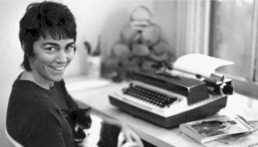These life stories may contain descriptions of childhood trauma and abuse, as well as images, voices and names of people now deceased. If you need help, you can find contact details for some relevant support services on our support page.
Prominent American author and LGBT activist, Rita Mae Brown (b. 1944), was in an orphanage as an infant before being adopted by members of her extended family.
Rita Mae Brown was born in Hanover, Pennsylvania on 28 November 1944. Her young, unmarried mother was unable to care for her and gave her up for adoption.
As an infant, Rita Mae lived in an orphanage until she was adopted at three months old by her mother’s cousins, Julia and Ralph Brown, a butcher. The working-class couple raised her in Pennsylvania until the family moved to Florida when Rita Mae was an adolescent.
Rita Mae Brown was a very sickly baby, causing her adoptive parents to worry that she would die. But she survived and learned to read at the age of three. As a child, Rita Mae had a tumultuous relationship with her adoptive mother who wanted her to conform to social norms. In fits of anger, Julia would call her daughter “the ill,” short for illegitimate.
Rita Mae Brown was a high-achieving student and athlete in high school. But at the age of fifteen, Brown’s adoptive father died. This was around the time that Rita Mae’s romantic interests in both women and men began. As a result, Rita Mae was ostracised and faced discrimination.
Brown won a scholarship to study at the University of Florida in 1962. However, in 1964 she was expelled for her involvement in the civil rights movement. Brown’s expulsion, however, was prompted when she disclosed her sexual orientation to sorority officers.
Next, Brown hitchhiked to New York City. She later won a scholarship at New York University and graduated with a degree in Classics & English in 1968. Brown went on to study a degree in cinematography from the New York School of Visual Arts. While living in New York City, Brown struggled financially and experienced homelessness.
Brown began campaigning for women’s rights as a university student. In 1969, Brown helped found the radical feminist group, Redstockings. She was also an early member of the National Organization for Women (NOW) but left in 1970 due to conflict with Betty Friedan and other members about her sexual orientation.
Brown co-founded “a lesbian feminist newspaper collective that stated that heterosexuality was the root of all oppression” (Barragan, 2018), the Student Homophile League, and the Radical Lesbians. During this time, she also published two volumes of radical feminist poetry, The Hand that Cradles the Rock (1971) and Songs to A Handsome Women (1973).
Brown earned a PhD from the Institute for Policy Studies in Washington DC in 1973. In the same year, she also published her underground classic novel, Rubyfruit Jungle. The book was controversial for defying negative stereotypes about lesbians through a coming-of-age story about a character named Molly Bolt.
Rubyfruit Jungle was originally published by a small Manhattan women’s collective, Daughters Inc. The first edition sold 70,000 copies. In 1977, Bantam Books, acquired the rights, and over a million copies were sold.
“Her work is known for being one of the early literary lesbian novels. Many lesbian readers have found Brown’s work relatable to their own experiences and observations” (Knick, 2020).
In the early 1970s, Brown pursued an academic career. She was a sociology lecturer at the Institute for Policy Studies, a research fellow, and a visiting faculty in feminist studies at Goddard College.
By the mid 1970s Brown was a very successful author. During this time, she began dating Martina Navratilova, a prominent tennis player. The couple moved in together in 1979; the relationship ended in 1981.
During the 1980s, Brown worked as television script writer in Hollywood. In 1982, she was nominated for an Emmy, and won the Writer’s Guild Best Television Variety show award for I Love Liberty.
Rita Mae Brown is a prolific author. She is particularly well-known for her mystery novel series. These include the “Sister” Jane series, the Mags Rogers series, and the Mrs Murphy series, which she co-authored with her cat, Sneaky Pie. Brown is also author of the Runnymede Series, which take place during WWII.
Brown’s earliest non-fiction book was Starting from Scratch: A Different Kind of Writers’ Manual (1988). She is also author of two memoirs, including Rita Will: Memoir of a Literary Rabble-Rouser (1997), and Animal Magnetism: My Life with Creatures Great and Small (2009). Brown’s screenplays include The Slumber Party Massacre, The Long Hot Summer, & My Two Loves.
Brown is an avid horseback rider and master of fox hounds. She lives with a menagerie of cats, dogs, and horses outside of Charlottesville, Virginia.
In a 1977 interview with the New York Times, Brown said she would like to live to an old age and be remembered for her books.
Brown desires that “people get over calling me ‘Rita Mae Brown, the lesbian author. I want them to remember me as ‘Rita Mae Brown, author. And I hope they say, ‘She was fun.’” (Klemesrud, 1977).
References
“Rita Mae Brown.” Rita Mae Brown website. https://ritamaebrownbooks.com/
“Rita Mae Brown.” The Poetry Foundation. https://www.poetryfoundation.org/poets/rita-mae-brown
“Rita Mae Brown 1944-” Encyclopedia. https://www.encyclopedia.com/arts/educational-magazines/brown-rita-mae-1944
Barragan, Carolina. (2018). “Rita Mae Brown.” Pennsylvania Center for the Book. https://pabook.libraries.psu.edu/literary-cultural-heritage-map-pa/bios/Brown__Rita_Mae#:~:text=During%20the%201970s%2C%20Brown%20cofounded,her%20farm%20in%20Charlottesville%2C%20Virginia.
Knick, Dawson. ‘Rita Mae Brown and Her “Rubyfruit Jungle,”’ Village Preservation Blog. 24 Apr 2020 https://www.villagepreservation.org/2020/04/24/rita-mae-brown-and-her-rubyfruit-jungle/
Klemesrud, Judy. “Underground Book Brings Fame to a Lesbian Author,” The New York Times. 26 Sept 1977. https://www.nytimes.com/1977/09/26/archives/underground-book-brings-fame-to-a-lesbian-author.html
Image available here.
